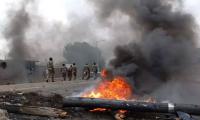LAHORE: A judicial magistrate has discharged crime reporter Fraz Nizam from an FIA case regarding his reporting on an alleged incestuous murder case.
The FIA had sought Nizam’s physical remand; he is a web journalist. However, the court dismissed the FIA’s request and expressed concern over the agency’s treatment of the journalist.
The case originated from a video Nizam recorded in 2023, in which he had interviewed two siblings accused of murder following an alleged incestuous relationship. The FIA’s cybercrime wing initiated proceedings based on a public petition by a lawyer, citing public interest. Despite Nizam’s assertion that the video adhered to journalistic ethics, the FIA charged him under sections 21(d), 24, and 24(a) of Pakistan’s Prevention of Electronic Crimes Act (PECA) 2016. These sections address content that could “entice” or “induce” illegal acts, with the FIA arguing that such reporting could negatively impact viewers, particularly young people.
Appearing before Judicial Magistrate Naeem Bakhsh, Nizam’s lawyer Zain Qureshi argued that the FIA had acted hastily and failed to provide the journalist with a copy of the First Information Report (FIR) or specify allegations. He contested the legality of the charges, stating that Section 21(d) of PECA applies only if a suspect directly incites or encourages explicit acts, which he argued Nizam’s video did not do. He argued that the footage was produced before any high court directive concerning such content, making retroactive charges inadmissible.
Magistrate Bakhsh expressed disapproval over the FIA’s frequent refusal to provide suspects with FIR copies, calling it a “concerning and recurring issue.” “This is the sixth case where the accused have not received FIR copies,” he said, emphasising that suspects have a fundamental right to know the charges against them.
He said that if the content was indeed problematic, the police officers present in Nizam’s video should also be subject to the same scrutiny—a point the FIA’s lawyer did not address. After reviewing arguments from both sides, Magistrate Bakhsh concluded that the charges under PECA were unsupported by the content of the interview. He discharged Nizam from the case, ruling that Sections 21(d) and 24(a) did not apply to the material presented.
“There is nothing in the video that brings the journalist’s conduct under these sections,” read the court’s decision, which also declared the FIR registration and investigation unwarranted without the magistrate’s express permission under PECA. Nizam’s detention has sparked condemnation from journalistic bodies and rights groups. The Lahore Press Club issued a statement criticising the FIA’s handling of the case and its treatment of Nizam. Lahore Press Club President Arshad Ansari called on the prime minister and interior minister to act against the FIA’s “continued harassment” of journalists, saying that Nizam’s video was recorded with official permission and in the presence of police officers.
In a separate statement, Nizam asserted that the interview was conducted professionally and intended to shed light on criminal issues affecting the community. “The report was in strict adherence to journalistic standards,” he said.
During his FIA custody, Nizam reportedly faced misconduct by the investigating officer, Rai Shakeel Ahmed, who allegedly threatened to shave his head. Nizam’s family reported that his mobile phone and CNIC were confiscated, despite his court-ordered release. The alleged mistreatment has intensified calls from journalist associations for accountability within the FIA.
The same day Nizam was detained, two other journalists—Salman Qureshi from a private news channel and female anchor Tehmina Sheikh—were reportedly implicated in similar cases.
Representational image of police tape at an incident site. — Unsplash/FileLAHORE : Around 10 people died, whereas...
Punjab Food Minister Bilal Yaseen seen in this image, released on March 12, 2024. — Facebook@bilalyaseen120LAHORE :...
Punjab Skills Development Fund officials seen in this group photo.— Facebook@PunjabSkillsDevelopmentFund/File ...
Chief Secretary Zahid Akhtar Zaman can be seen in this screengrab. — Facebook@ChiefSecretaryPunjab/File LAHORE :...
A representational image shows road construction site.— Facebook@cpecsilkroutepakchina/File LAHORE : Provincial...
An arms seller in Darra Adamkhel picks an assault rifle from a shelf at his shop. — AFP/FileLAHORE : The Punjab Home...







